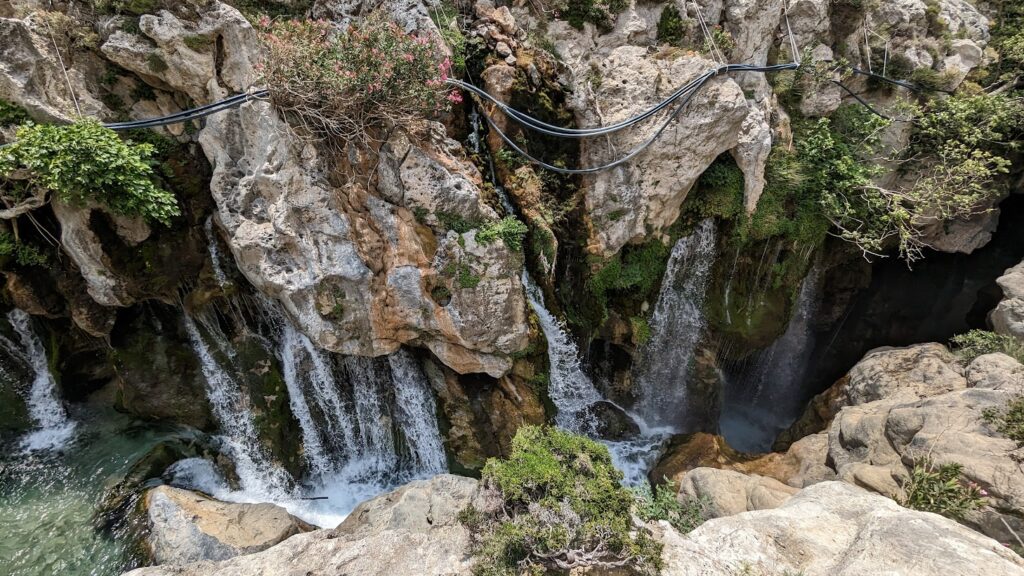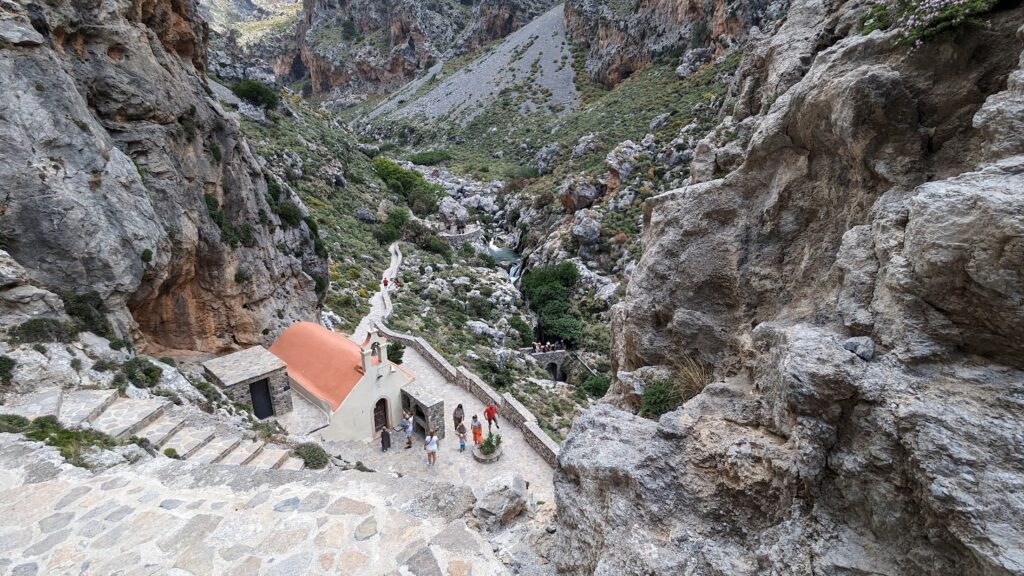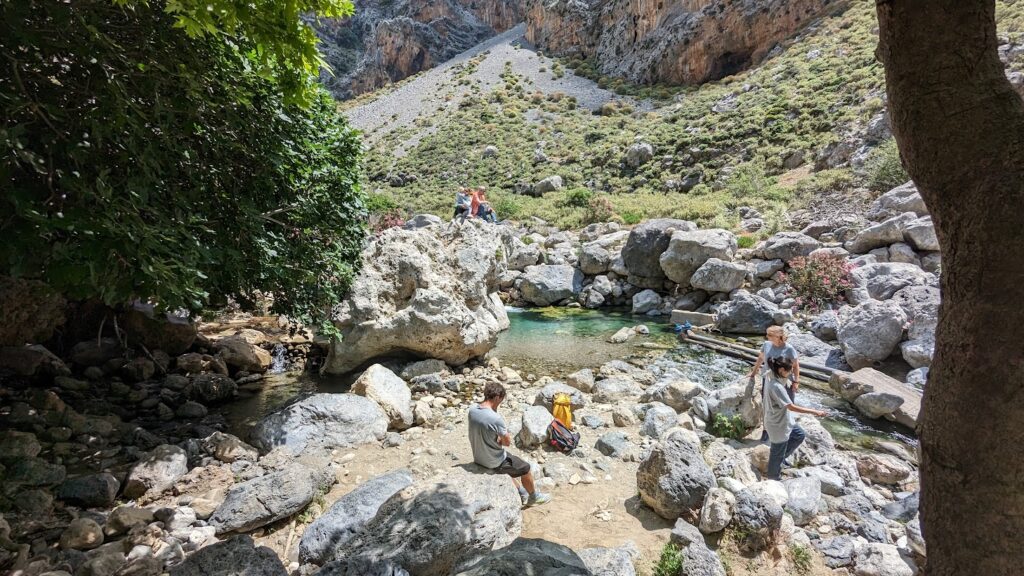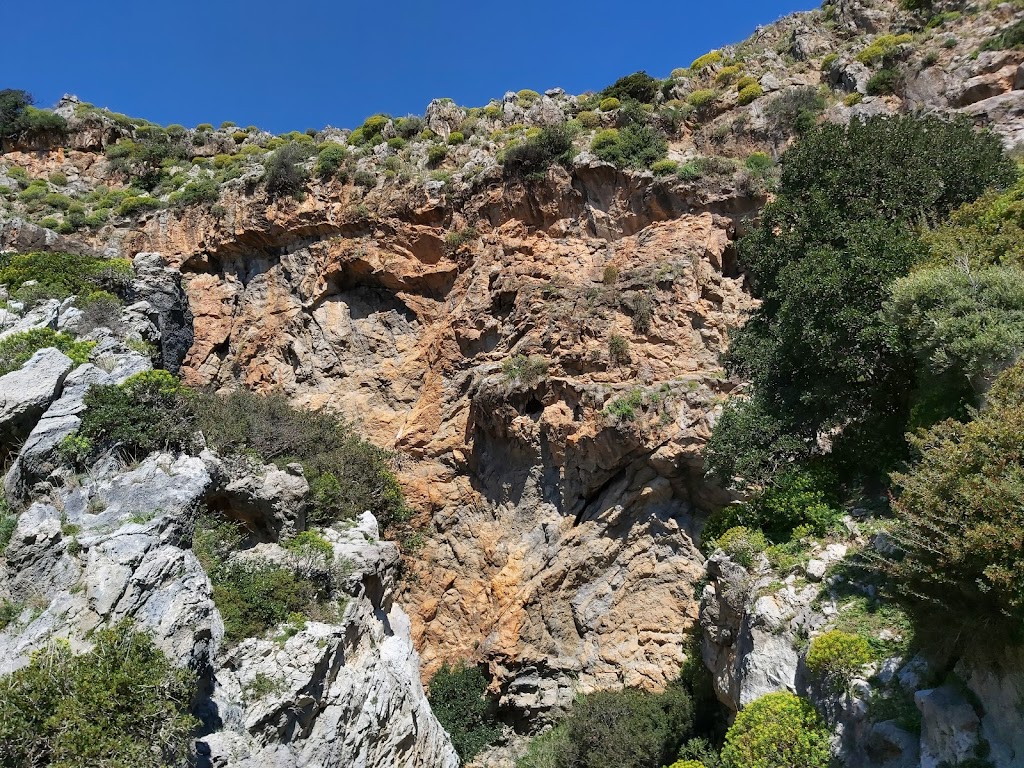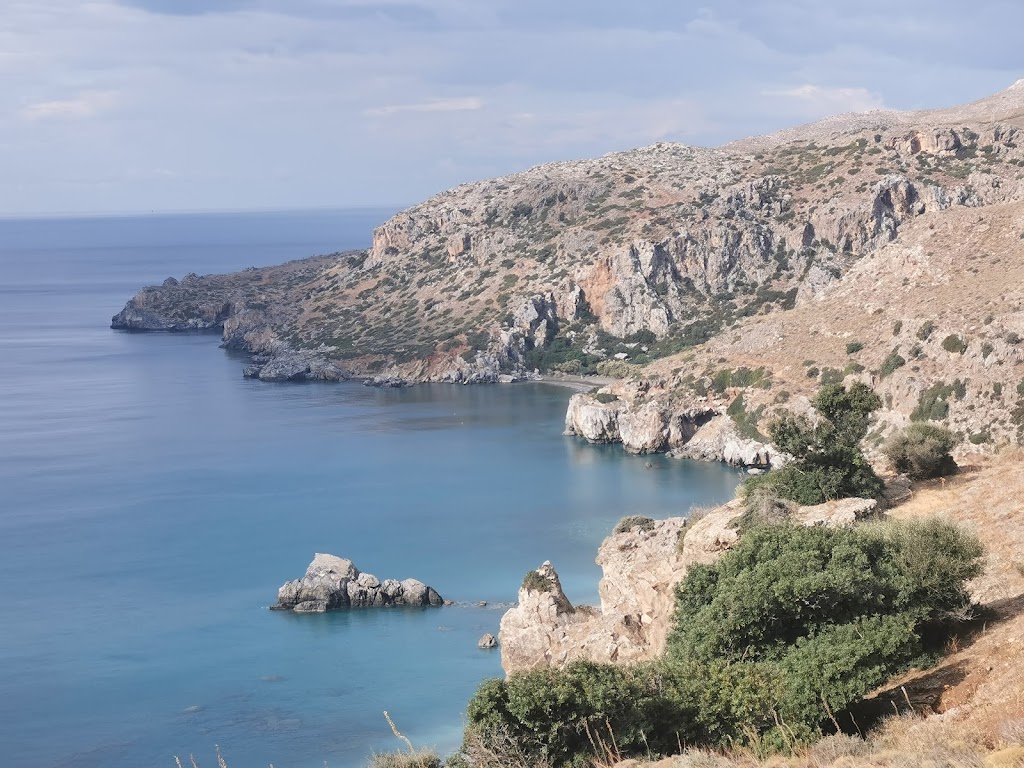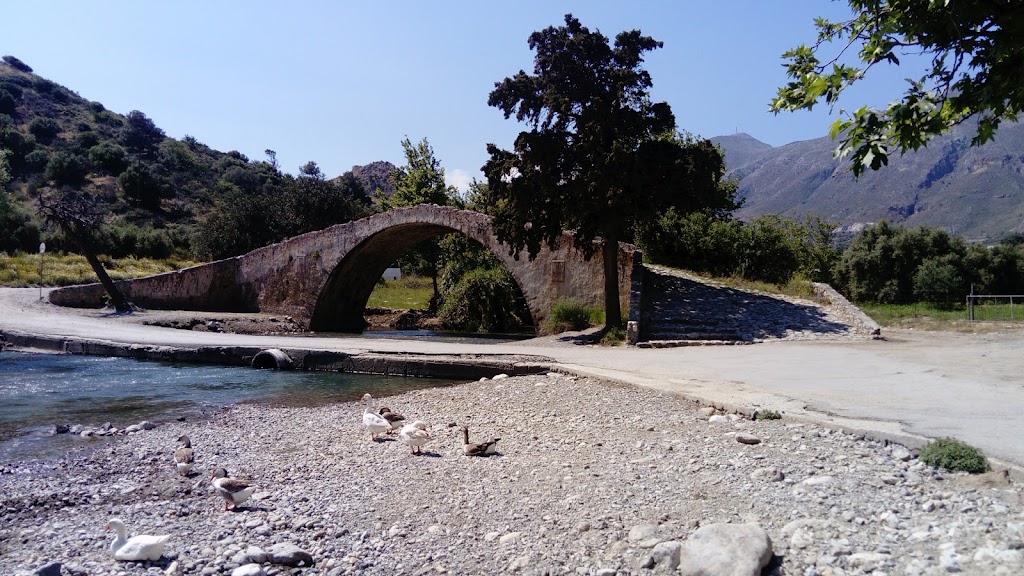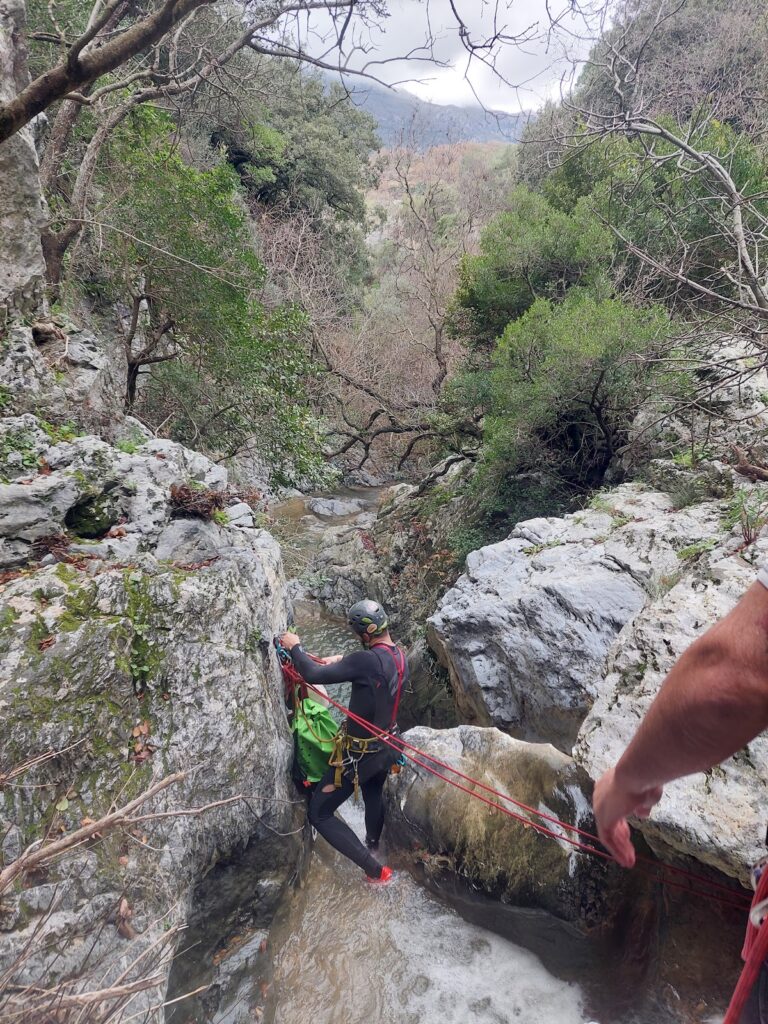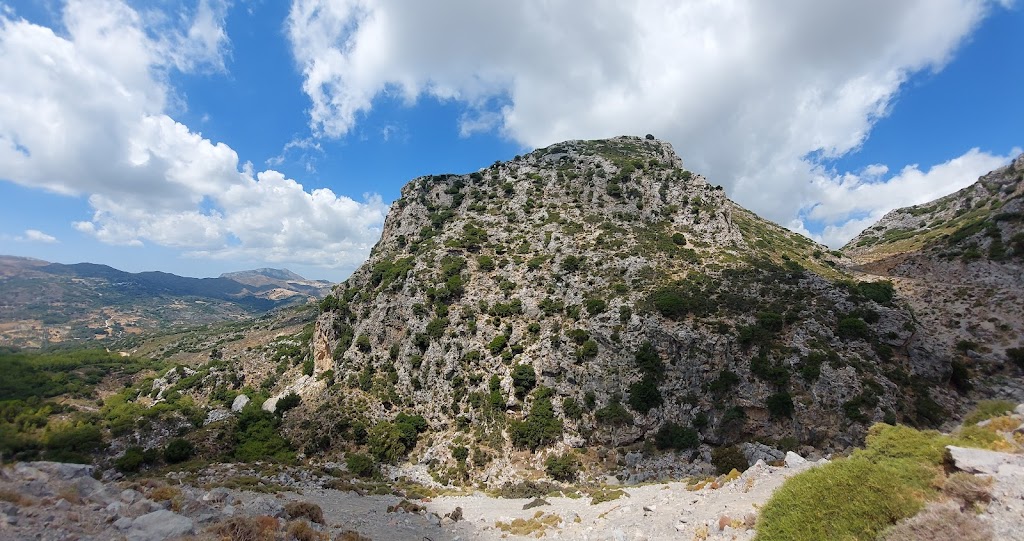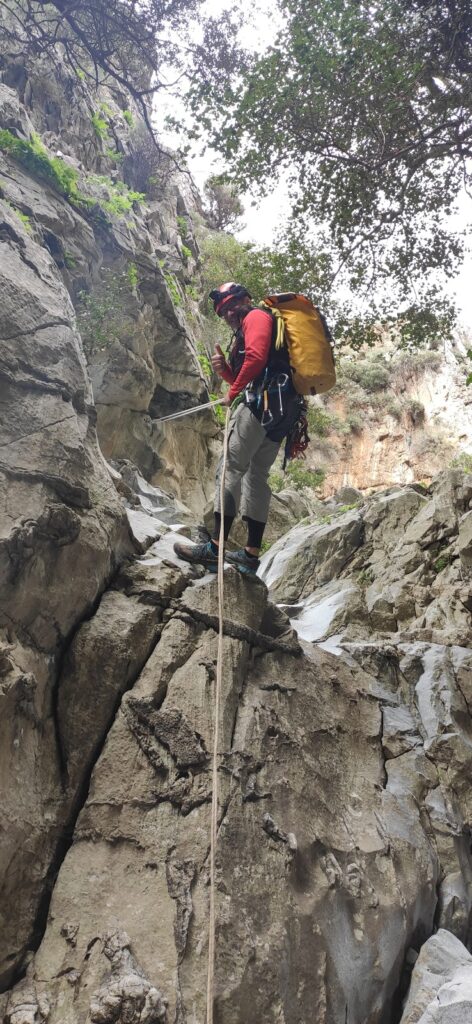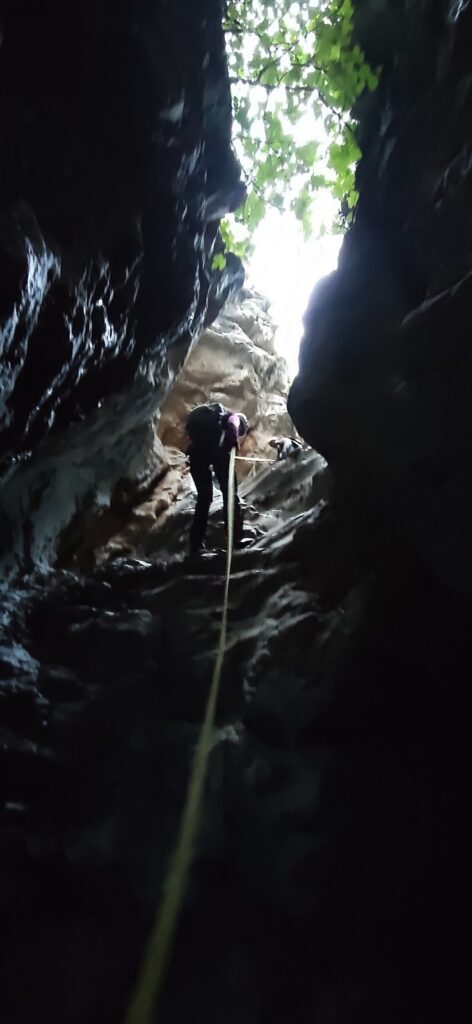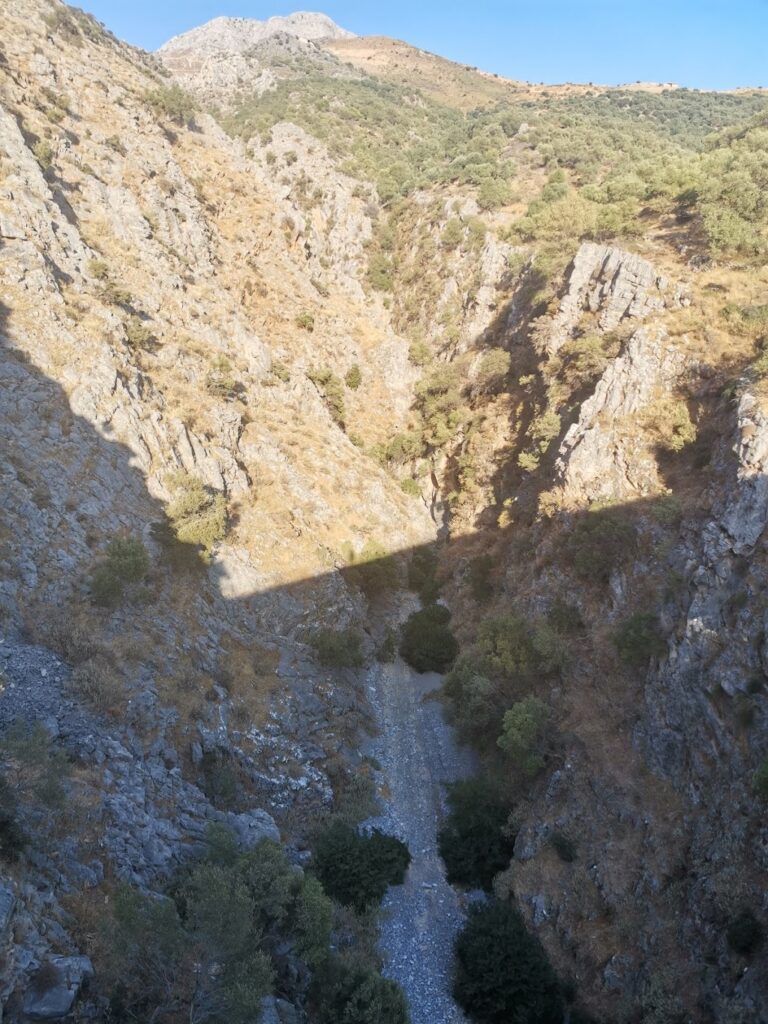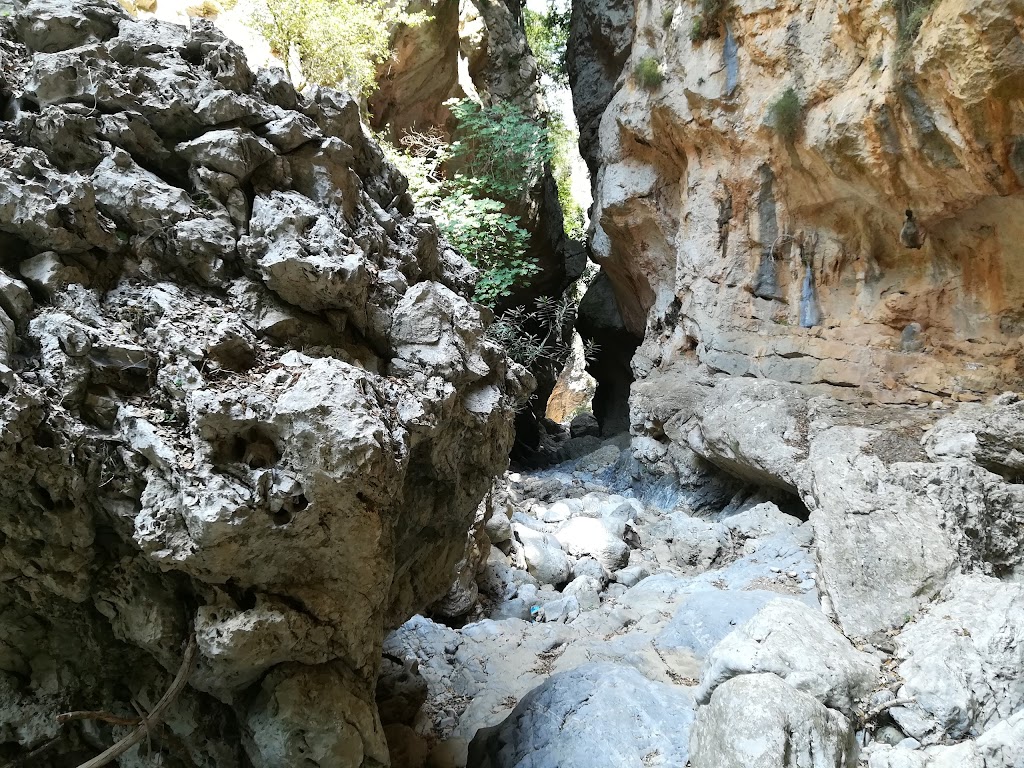Gorges to hike and walk near Lefkógeia, in Rethymno region
List of Gorges near Lefkógeia
- 2.8 km
- Kourtaliotis Gorge at Preveli
- 7 km
- 4 h
- Hiking
Situated 22km south of Rethymno, Kourtaliotis Gorge, with its stunning 3km length, stands as one of Rethymno’s most breathtaking natural wonders. The gorge originates from the village of Koxare, weaving its way between the towering Kouroupa and Koules mountains of the Xiro Oros range. The dramatic cliffs of the gorge, reaching heights of up to 600 meters, house numerous caves and openings, offering a home to a variety of unique fauna.
This majestic landscape is adorned by the Kourtaliotis River, which continues its course until it merges with the Frati Gorge and ultimately leads to Lake Preveli, taking on the name Megalos River in its final stages.
The beauty of this gorge can be experienced by following a paved road that cuts through the canyon. Steps from the Koxare-Asomatos street will guide you to the gorge’s base, where you’ll find the chapel of the local Saint Nicholas Kourtaliotis. One of the standout attractions here are the springs of Kourtaliotis, nestled near the chapel. Further exploration reveals Kourtaliotis’ stunning waterfall, accessible by swimming from a lower river level, leading to a darker, narrower part of the gorge.
A trek along the river takes you to the Megalos River bridge and onwards to Preveli’s palm beach. Kourtaliotiko gorge is a treasure trove of aesthetics, biodiversity, and ecological significance. Beyond its dense Cretan Date Palm trees, the second-largest palm forest on Crete, the gorge’s slopes are home to lush vegetation. The river’s estuary features sand dunes and formations of protected marine plants like Posidonia. It also provides a habitat for local species like the tortoise and freshwater snake.

- 4.1 km
- Swallows' Gorge
- 6.5 km
- 4 h
- Hiking
The Swallow Gorge, situated 33km south of Rethymnon city, is in close proximity to the renowned Preveli beach, known for its magnificent palm grove and breathtaking river. The gorge begins from Kenda peak (881m altitude), passes through Drymiskos village, runs nearly parallel to the Kourtaliotiko canyon, and concludes at Drymiskiano Ammoudi beach. It gets its name from the swallows that flock here every summer.
Unlike Kourtaliotiko, this lesser-known canyon is dry during the summer but is still worth a visit. The vertical, awe-striking rocks and the verdant riverbed (which flows in winter) are a sight to behold. The winding Swallow Canyon is relatively easy to hike and doesn’t require any specific skills, despite not being marked.
A significant portion of the canyon runs parallel to the road leading to Amoudi beach, which is where the easy trail to Preveli begins. To find this road, take a left at the picturesque arched bridge of Megalos Potamos that you’ll come across en route to the Preveli monastery. Therefore, even if you’re not much of a walker, you can still enjoy the beauty of the gorge during your visit to Preveli.

- 6.2 km
- Kotsyfos Gorge
- 2 km
- 2 h
- Hiking
The gorge of Kotsifos starts at Kannevos village and ends at Plakias. The starting point is very narrow with a width of about 10m, which gradually increases and reaches 600m. The total length is 1800m, and the almost vertical sides that reach a height of 600m. Inside the gorge, there is a small temple built inside a rocky cavity dedicated to Saint Nicholas.
Hiking in the upper part of the gorge (Kanevos – Bridge of Sellia).
Starting from the village Kanevos you can start hiking on the riverbed and reach the bridge that connects villages Selia and Myrthios (after about one hour of course). Along the way, there are large boulders that block the passage, but with a little attention, you can overcome them. At one point the side-gorge of Boutsinas meets Kotsyfos with an impressive waterfall of 20 meters. In summer the riverbed is dry.
Course in the upper part of the gorge (Bridge of Sellia – Plakias)
At the location of the bridge that heads to Selia, the canyon gradually turns into a wide valley. You can continue our course at the bottom of the gorge, along the riverbed. After meeting a modern temple, after 3-4 minutes you meet a dirt road that heads backwards (opposite the flow of the river). If you follow this road in a few minutes you will meet the springs of Kotsifos where a pond is formed (surrounding villages get water from here). From here onwards, the river has a water flow throughout the year emptying on the beach of Plakias.
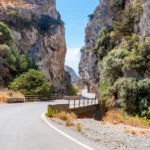
- 7.5 km
- Kakoperatos Gorge at Agios Vasilios
- 0.9 km
- 3 h
- Canyoneering equipment needed
Kakoperatos Canyon, situated near the village of Agios Vasilios in the province of the same name, is a tributary of the Megalos River (Kourtaliotis). Its name, which translates to “bad passage” in Greek, indicates the necessity of technical equipment for human access. This stunningly scenic and rugged canyon is perfect for canyoning. It is endowed with water for most of the year and features 7-8 remarkable waterfalls. These create deep ponds filled with clear turquoise waters, making them ideal for jumping.
It’s likely that no other canyon in Crete boasts such vibrant turquoise waters. The canyon’s exit is located adjacent to the last residences of Agios Vasilios, with its stream flowing through the village courtyards!
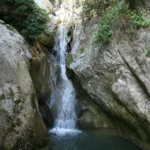
- 10.1 km
- Agia Fotia Gorge
- 1 km
- 1.5 h
- Hiking
Approximately 1 km to the east of Spili, in the Agios Vassilios province, you’ll find the church of Agia Fotini, also known as Saint Photini. Like many places in Crete, it’s often referred to as Agia Fotia. Situated on the main road leading to Agia Galini, the church is adjacent to a spring that flows with water throughout the year. Nearby, you’ll see a large, old watermill. This area marks the end of the picturesque Agia Fotia gorge, which is small but incredibly lush.
The gorge begins at the Gious Kambos plateau, which is 750m above sea level, and concludes at the spring, which sits at an altitude of 500m, after a 1.5km journey.
Close to the gorge’s starting point, you’ll discover waterfalls of unparalleled beauty. In the springtime, these falls are abundant with water, creating a unique and breathtaking landscape filled with plane trees. The easiest way to reach the waterfalls is by walking from the spring along the gorge. Alternatively, you can access them from Gious Kambos, though this route is more challenging. It requires bypassing the waterfalls from the sides and descending the steep slope to the riverbed.
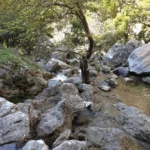
- 11.1 km
- Kissos Gorge
- 1 km
- 1.5 h
Located just 1km north of Kissos village in Agios Vasilios province and 34km southeast of Rethymnon, Kissano Gorge serves as a link between Kambos Kissou settlement and the small Gious Kambos plateau. The gorge’s river is a primary tributary of the Gorge Frati. The canyon, though not lush with vegetation, boasts small waterfalls, the tallest of which measure between 5-7m. These waterfalls make it an ideal location for canyoning, but it’s also possible to bypass them carefully from the sides without any specialized equipment.
The journey begins at the Gious Kambos plateau, a small haven of diverse flora. A 0 to 30-minute walk along or beside the riverbed leads you to a point where the river intersects the road connecting Kissos with Gerakari. Here, you’ll find a striking reddish rock peppered with numerous caverns known as Kokkinos Detis, leading locals to also refer to this area as the Kokkinos Detis Gorge.
While this marks the end of the main part of the canyon, the river continues its descent, creating more small waterfalls. It then passes through the 60-hectare artificial pine forest of Vatolakki, before continuing towards Spili and eventually to Frati.
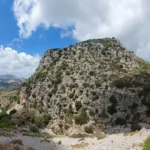
- 11.4 km
- Rodakino Gorge
- 3.2 km
- 6 h
The canyon, located to the north of Rodakino village, requires canyoning equipment for access. It begins to the south of Kryoneritis Mount’s peak and extends for 5km before merging with the SykiaSykia canyon, just prior to the Rodakino bridge. The stretch before the Sikia junction features 16 rappels, and there are an additional 4 rappels in the Sikia gorge leading up to the bridge.
Most of the year, the canyon is dry, and in many spots, it narrows to just 1.5m. Typically, canyoners enter the gorge midway, not at the beginning. To find the entrance, one must drive on a dirt road that starts in Rodakino and ends at a sheepfold roughly 2.5km to the northeast. From there, a small stream is descended until the canyon’s riverbed is reached. This part of the canyon has a maximum rappel of 15m and takes around four hours to traverse.
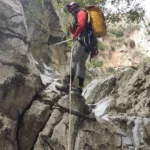
- 11.8 km
- Sykia Gorge at Rodakino
The stunning Sykia gorge, which is actually the easternmost gorge in the province of Sfakia, is located north of Rodakino village. It’s a technical canyon, meaning that traversing it requires specialized equipment due to its over 10 steep descents or waterfalls, which are safeguarded by the speleological groups of Crete. The tallest rappel stands at around 12 meters high.
The Sykia stream combines with the untamed canyons of Rodakino (also known as Maglinara) and the longest gorge in the area, Karavos. The stream then flows under both the new and old bridges of Rodakino, finally reaching the picturesque Korakas beach. Canyon explorers typically leave the gorge just after the old bridge, while those up for a full-length trek will encounter another rappel. The narrowest part of Sykia, after it merges with the Rodakino Gorge, is truly breathtaking.
Speleological clubs have named the gorge Sykia, meaning sycamore-fig tree, due to the abundance of fig trees found along the route. However, its official name is Xepitira. Except for times following heavy rainfall, the gorge is typically dry.

- 12.7 km
- Moundros Gorge (Kollita)
- 2 h
- E4 trail
The Twin Ravines, or Kollita Gorges, are situated near the scenic village of Argyroupolis, approximately 22km southwest of the city of Rethymnon. The name derives from two adjacent canyons that conclude near the village of Kato Poros. The eastern canyon, Moundros Gorge, is bordered by the Vigla peak (567m) to the east and Nissiani hill to the west, which houses the deserted Nissi settlement. West of Moundros gorge lies the Vilandredo gorge, named after the village at its entrance and more commonly referred to as Kollita Gorge.
These gorges are perfect for casual hikers due to their ease and stunning beauty. They are particularly suitable for groups of friends who can park in Kato Poros or Argyroupoli, explore the Moundriano canyon, and return via the second Kollita Gorge.
Suggested Two Gorges Route
Starting from the verdant Argiroupoli, built on the ancient city of Lappa, we journey east to the village of Moundros, known for its springs and fountains. The village is home to many beautiful Venetian structures (old courts, prisons, and noble houses) and the churches of Saint Constantine, Saints Anargyri (11th century), and Saint Nicholas are well worth a visit. Don’t forget to wander the narrow streets of Moundros. Close to Moundros, the deserted Nissi settlement, famous for its stunning stone structures, can be found.
From the village, the entrance to the verdant Moundros gorge is accessible, leading to the village of Velonado. A well-defined path descends to the riverbed, which is usually filled with water. The canyon is filled with towering plane trees and several fresh water ponds. After roughly 1.5 hours of walking, we reach the southern entrance of Moundriano Gorge, near Velonado.
Upon exiting the canyon, we follow the asphalt road west to the entrance of the second canyon, Kollita Gorge, near Vilandredo. This canyon, more magnificent than Moundriano, is lush with plane trees, and the path follows the riverbed. The most beautiful section of the canyon is where the high walls nearly touch, forming a narrow passage. Fig and holly trees can be seen on the gorge’s slopes, hanging overhead. After approximately four hours, we exit the canyon, which once provided water for the Roman baths of Lappa, now Argyroupolis.
Following the ancient stone path through laurels, myrtles, and hollies, we reach Kato Poros and the area of Pente Parthenes (Five Virgins). Here, one can find the spring beneath the perennial plane tree of Pente Parthenes, the chapel of the Five Virgins, and the Hellenistic and Roman tombs of Lappa. From here, the trail broadens and leads us back to the lush green Argiroupoli. In Argiroupoli, the Venetian buildings, churches, and picturesque alleys are worth a visit. A popular attraction is the springs of Argyroupolis, with the most notable spring located in the cavernous chapel of Agia Dynami. The area is lush with several small waterfalls and numerous restaurants.

- 13.6 km
- Kollita Gorges (Vilandredo)
- 4 km
- 2.5 h
- E4 trail
The Twin Ravines, or Kollita Gorges, can be found near the charming village of Argyroupolis, approximately 22km southwest of the city of Rethymnon. The name refers to the two parallel canyons that conclude near the village of Kato Poros. The easternmost canyon, Moundros Gorge, is bordered by the Vigla peak (567m) to the east and the Nissiani hill to the west, where you can find the abandoned settlement of Nissi. Adjacent to Moundros Gorge to the west, is the Vilandredo Gorge, named after the village at its entrance and often referred to as Kollita Gorge.
The gorges offer an ideal hiking experience for novices due to their ease and stunning surroundings. It’s a perfect outing for groups of friends – park your car in Kato Poros or Argyroupolis, explore the Moundriano canyon, and return via the second Kollita Gorge for a round trip.
A suggested itinerary for the two gorges starts in the verdant Argiroupoli, built on the site of the ancient city of Lappa. From there, head east to the village of Moundros, known for its springs, fountains, and beautiful Venetian architecture. Don’t miss a stroll through the narrow streets of Moundros and a visit to the churches of Saint Constantine, Saints Anargyri (11th century), and Saint Nicholas. Near Moundros, you’ll find the deserted settlement of Nissi, notable for its impressive stone structures.
From the village, make your way to the northern entrance of the lush Moundros Gorge, which leads to the village of Velonado. A well-marked path descends to the riverbed, which is typically full of water. The canyon boasts towering plane trees and several freshwater ponds. After about a 1.5-hour walk, you’ll reach the southern entrance of Moundriano Gorge near Velonado.
Exiting the canyon, head west on the asphalt road to the entrance of the second canyon, Kollita Gorge, near Vilandredo. This canyon is even more impressive than Moundriano, filled with plane trees and a path that runs along the riverbed. The most breathtaking part of the canyon is where its towering walls nearly touch, creating a very narrow passage. Along the slopes of the gorge, you’ll spot numerous fig and holly trees. After a total of four hours, you’ll exit the canyon, which once supplied water to the Roman baths of Lappa, now Argyroupolis.
Following the old stone path amidst laurels, myrtles, and hollies, you’ll reach Kato Poros and the area of Pente Parthenes (Five Virgins). Here, you’ll find a spring under the perennial plane tree of Pente Parthenes, the chapel of the Five Virgins, and the Hellenistic and Roman tombs of Lappa. From here, the trail broadens and leads back to the lush green Argiroupoli. In Argiroupoli, be sure to visit the Venetian buildings, churches, and picturesque alleyways. The springs of Argyroupolis are a popular attraction, particularly the spring in the cavernous chapel of Agia Dynami. The area is lush with several small waterfalls and numerous restaurants.
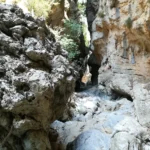
- 14.6 km
- Patsos Gorge
- 5 km
- 2.5 h
- Hiking
Located in the stunning province of Amari, the Patsos or Agios Antonios gorge is situated 8 km southwest of Arkadi Monastery. The gorge’s water is collected in the Potami dam. Trekking through the gorge is relatively easy up to a certain point, thanks to a well-marked trail created by the forest service. This trail concludes at the gorge’s narrowest point, where a unique waterfall cascades into a cave. Beyond this point, the gorge narrows and forms several small waterfalls. The descent to the Potami lake demands careful attention, particularly during winter and spring. Another path leads to the avifauna watchtower situated above the river.
The Patsos Gorge is renowned for Agios Antonios’ cavernous temple (Saint Anthony), which was once a sacred cave dedicated to Kraneos Hermes in ancient times. Water seeps from the rocks and drips from the temple roof, accumulating as holy water. It’s fascinating to observe the thousands of prayer papers that devotees have tucked into the rock cavities surrounding the temple. Large plateaus with wooden benches and tables, perfect for picnicking, are located beneath the temple and by the river.
The gorge derives its name from Patsos, a village nestled at the base of Mount Soros at an altitude of 490 meters. It’s approximately 30 km south of Rethymnon. The area boasts a rich variety of flora due to the numerous springs throughout the region that provide a year-round water supply.
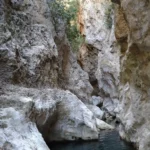
No results available
ResetGorges in other nearby areas
No results available
Reset